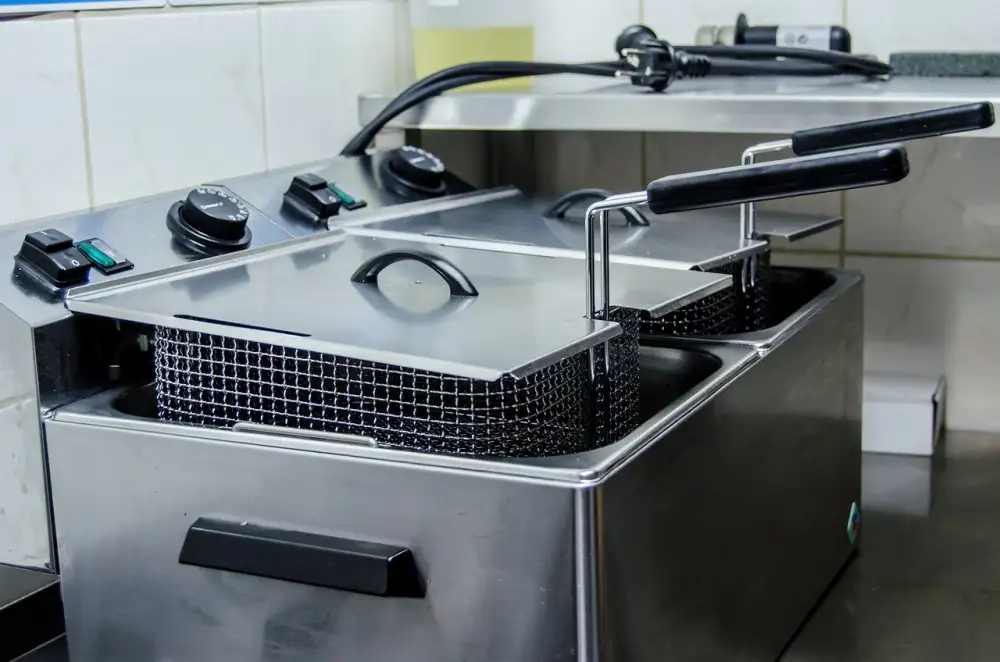Air Fryer Toxic: Unveiling the Potential Health Risks of this Popular Kitchen Appliance

Air fryers have gained immense popularity in recent years as a healthier alternative to traditional deep frying. These countertop appliances use hot air circulation to cook food, giving it a crispy texture similar to deep-fried dishes but with significantly less oil. Air fryers are praised for their ability to reduce fat content and calories in fried foods, making them an attractive option for health-conscious individuals. However, it is important to understand that despite their benefits, air fryers may pose potential health risks that need to be considered before incorporating them into your kitchen routine.
Understanding the Potential Health Risks
While air fryers have gained popularity for their ability to cook crispy and delicious food with less oil, it is important to be aware of the potential health risks associated with this kitchen appliance. Despite their claims of being a healthier alternative to deep frying, air fryers still pose certain dangers to our well-being.
One of the main concerns is the release of harmful chemicals during the cooking process. When foods high in fat and protein are exposed to high temperatures, they can produce acrylamide, a known carcinogen. This chemical has been linked to an increased risk of cancer and other health issues.
Additionally, air fryers can impact cardiovascular health. The excessive consumption of fried foods, even when cooked in an air fryer, can lead to elevated cholesterol levels and increase the risk of heart disease. The high heat used in air frying can also cause oxidation of fats, which further contributes to cardiovascular problems.
Furthermore, using an air fryer regularly may contribute to weight gain and diabetes. Fried foods cooked in these appliances often contain high amounts of calories and unhealthy fats. Consuming these on a regular basis can lead to obesity and insulin resistance, increasing the likelihood of developing type 2 diabetes.
In conclusion, while air fryers may seem like a convenient and healthier option for cooking crispy foods, it is crucial to understand the potential health risks they pose. By being aware of the harmful chemicals released during cooking, their impact on cardiovascular health, and the increased risk of obesity and diabetes associated with frequent use, individuals can make informed choices for their overall well-being.
Harmful Chemicals Released During Cooking
While air fryers have gained popularity for their ability to cook food with less oil, there is growing concern about the release of harmful chemicals during the cooking process. When foods are cooked at high temperatures, such as in an air fryer, certain chemical reactions occur that can produce potentially toxic compounds.
One such compound is acrylamide, which forms when starchy foods like potatoes and bread are cooked at high temperatures. Acrylamide has been classified as a probable human carcinogen by the International Agency for Research on Cancer (IARC). It has been linked to an increased risk of cancer, particularly in organs such as the kidneys and reproductive system.
Another chemical released during cooking is polycyclic aromatic hydrocarbons (PAHs). PAHs are formed when fat drips onto hot surfaces or when meat is charred. These compounds have been associated with an increased risk of various types of cancer, including lung, bladder, and skin cancer.
Furthermore, cooking meats at high temperatures can lead to the formation of heterocyclic amines (HCAs) and advanced glycation end products (AGEs). HCAs are formed when amino acids react with creatine in meat during high-heat cooking methods like grilling or frying. Some studies suggest that HCAs may be carcinogenic and increase the risk of colorectal and stomach cancers. AGEs form when sugars react with proteins or fats during cooking. They have been linked to inflammation and oxidative stress in the body.
It is important to note that while these harmful chemicals can be produced during cooking in general, air fryers may exacerbate their formation due to the intense heat generated within a confined space. This raises concerns about long-term exposure to these toxins through regular consumption of air-fried foods.
To minimize your exposure to these harmful chemicals, it is recommended to avoid overcooking or charring foods in the air fryer. Use lower temperatures and shorter cooking times whenever possible. Additionally, consider diversifying your cooking methods by incorporating steaming, boiling, or baking as healthier alternatives.
By being aware of the potential health risks associated with air fryers and taking steps to minimize exposure to harmful chemicals, you can make informed choices for your overall well-being.
Impact on Cardiovascular Health
Air Fryer Toxic: Unveiling the Potential Health Risks of this Popular Kitchen Appliance
2. Understanding the Potential Health Risks
...
4. Impact on Cardiovascular Health
While air fryers are marketed as a healthier alternative to deep frying, their impact on cardiovascular health should not be overlooked. The excessive consumption of fried foods, even if prepared in an air fryer, can still contribute to heart disease and other cardiovascular problems.
One major concern is the high levels of saturated fats that are often present in fried foods. These fats can raise cholesterol levels and increase the risk of developing clogged arteries. Furthermore, the process of frying can also lead to the formation of harmful trans fats, which have been linked to an increased risk of heart disease.
Additionally, cooking at high temperatures in an air fryer can cause the release of advanced glycation end products (AGEs). These compounds have been associated with inflammation and oxidative stress, both of which can negatively impact cardiovascular health.
It is important to note that moderation is key when it comes to using air fryers or consuming fried foods. Limiting the frequency and portion sizes of fried meals can help reduce the potential negative effects on your heart health.
By being mindful of your overall diet and incorporating a variety of healthy cooking methods, such as baking or grilling, you can minimize the impact on your cardiovascular system while still enjoying delicious meals prepared with an air fryer.
In conclusion, while air fryers offer a convenient way to prepare crispy foods with less oil, it is essential to consider their potential impact on cardiovascular health. By making informed choices and balancing your diet with other cooking methods, you can enjoy the benefits of an air fryer without compromising your well-being.
Increased Risk of Obesity and Diabetes
Air fryers have gained popularity for their ability to cook food with minimal oil, making them a seemingly healthier alternative to traditional frying methods. However, recent studies suggest that air fryers may actually increase the risk of obesity and diabetes.
One of the main reasons for this increased risk is the high calorie content of certain foods that are commonly cooked in air fryers. While it is true that air fryers require less oil, many people compensate by using high-fat ingredients or consuming larger portions. This can lead to an excessive intake of calories, which can contribute to weight gain and ultimately increase the risk of obesity.
Additionally, air frying can also lead to the formation of harmful compounds called advanced glycation end products (AGEs). These compounds are formed when proteins and sugars react at high temperatures, such as during the cooking process in an air fryer. Research has shown that a diet high in AGEs can promote inflammation and insulin resistance, both of which are key factors in the development of type 2 diabetes.
Furthermore, air-fried foods often lack important nutrients found in whole foods. The excessive heat used in air frying can destroy certain vitamins and minerals present in fresh ingredients. This means that while you may be reducing your fat intake by using an air fryer, you could also be missing out on essential nutrients needed for overall health.
To minimize these risks, it is important to choose healthier ingredients when using an air fryer. Opt for lean proteins like chicken breast or fish instead of fatty cuts of meat. Include plenty of vegetables to add fiber and nutrients to your meals. And most importantly, practice portion control to avoid overeating calorie-dense foods.
While air fryers may seem like a convenient and healthy cooking option, it is crucial to be aware of their potential risks. By making informed choices about what you cook and how much you consume, you can enjoy the benefits of this kitchen appliance without compromising your health.
Potential for Acrylamide Formation
Acrylamide is a potentially harmful chemical that can form when certain foods are cooked at high temperatures, such as in an air fryer. This chemical forms when starchy foods, like potatoes and bread, are exposed to high heat during the cooking process.
Studies have shown that acrylamide is a known carcinogen and has been linked to an increased risk of cancer in animals. While the evidence in humans is still limited, it is best to err on the side of caution and minimize our exposure to this chemical.
When using an air fryer, it's important to be mindful of the cooking time and temperature. Overcooking or cooking at excessively high temperatures can increase the formation of acrylamide. It is recommended to follow the manufacturer's instructions and avoid prolonged cooking times or excessively high temperatures.
Additionally, there are certain steps you can take to reduce acrylamide formation when using an air fryer. Soaking potatoes in water for 15-30 minutes before cooking can help remove some of the starch content, which can reduce acrylamide formation. Preheating the air fryer before adding food can also help reduce cooking time and minimize acrylamide formation.
It's worth noting that while air frying may be a healthier alternative to deep frying in terms of reducing oil consumption, it does not eliminate the potential health risks associated with acrylamide formation. Therefore, moderation and variety in cooking methods should be practiced to minimize overall exposure.
By being aware of the potential for acrylamide formation and taking steps to minimize its occurrence, we can make more informed choices for our health when using air fryers or any other cooking appliance.
Tips for Minimizing Health Risks
To minimize the potential health risks associated with air fryers, there are a few tips to keep in mind. Firstly, it is important to choose high-quality cooking oils with a high smoke point, such as avocado or coconut oil, as these are less likely to release harmful chemicals when heated at high temperatures. Additionally, avoid using excessive amounts of oil when cooking in an air fryer, as this can increase the production of acrylamide.
Another tip is to avoid overcrowding the food in the air fryer basket. Overcrowding can lead to uneven cooking and may result in higher levels of acrylamide formation. It is recommended to cook food in batches if necessary.
Furthermore, it is crucial to clean the air fryer regularly and thoroughly. Residue from previous cooking sessions can accumulate and release harmful chemicals when reheated. Follow the manufacturer's instructions for cleaning and maintenance.
Lastly, it is essential to maintain a balanced diet overall. While air frying can be a healthier alternative to deep-frying, it should not replace other methods of cooking entirely. Incorporate a variety of cooking techniques into your routine and focus on consuming a wide range of nutrient-dense foods for optimal health.
By following these tips and being mindful of the potential health risks associated with air fryers, you can enjoy the convenience and deliciousness they offer while minimizing any negative impacts on your well-being.
In conclusion, while air fryers have gained popularity for their ability to cook crispy and delicious meals with less oil, it is important to be aware of the potential health risks associated with their use. The release of harmful chemicals during cooking, such as acrylamide, can have detrimental effects on cardiovascular health and increase the risk of obesity and diabetes. However, by following some simple tips like using healthier cooking oils, avoiding processed foods, and practicing moderation, you can minimize these risks. Ultimately, making informed choices about your cooking methods and prioritizing your health should be the top priority when using any kitchen appliance.
Published: 18. 12. 2023
Category: Health



